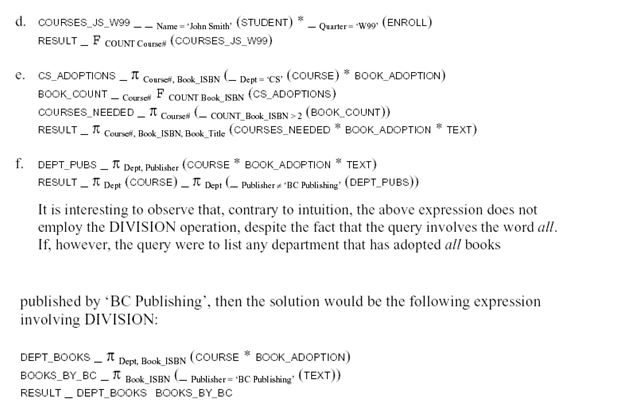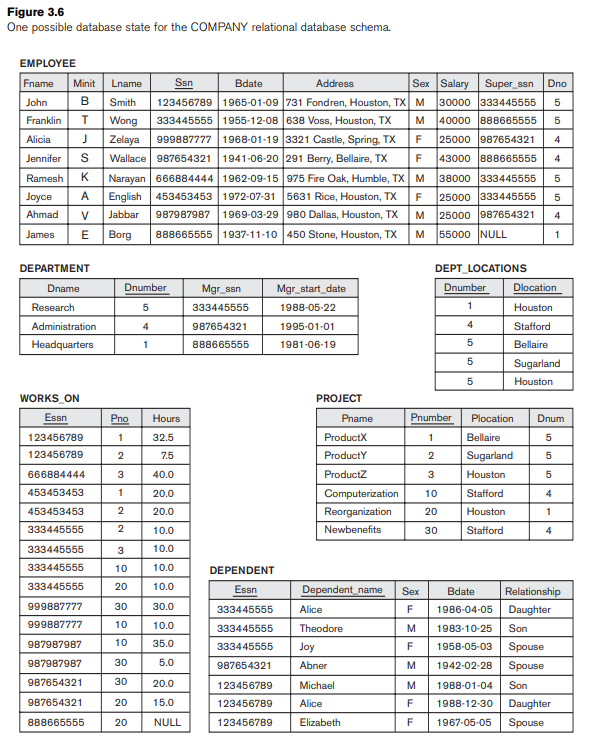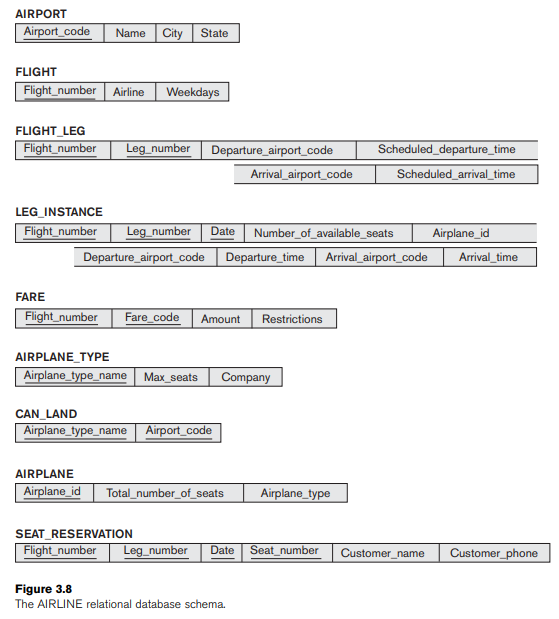Deck 3: The Basic Flat Relational Model
سؤال
سؤال
سؤال
سؤال
سؤال
سؤال
سؤال
سؤال
سؤال

فتح الحزمة
قم بالتسجيل لفتح البطاقات في هذه المجموعة!
Unlock Deck
Unlock Deck
1/9
العب
ملء الشاشة (f)
Deck 3: The Basic Flat Relational Model
1
Consider the following relations for a database that keeps track of student enrollment in courses and the books adopted for each course:
STUDENT (SSN, Name, Major, Bdate)
COURSE (Course#, Quarter, Grade)
ENROLL (SSN, Course#, Quarter, Grade)
BOOK_ADOPTION (Course#, Quarter, Book_ISBN)
TEXT (Book_ISBN, Book_Title, Publisher, Author)
Specify the foreign keys for this schema, stating any assumptions you make.
STUDENT (SSN, Name, Major, Bdate)
COURSE (Course#, Quarter, Grade)
ENROLL (SSN, Course#, Quarter, Grade)
BOOK_ADOPTION (Course#, Quarter, Book_ISBN)
TEXT (Book_ISBN, Book_Title, Publisher, Author)
Specify the foreign keys for this schema, stating any assumptions you make.
The schema of this question has the following four foreign keys:
3. the attribute SSN of relation ENROLL that references relation STUDENT,
4. the attribute Course# in relation ENROLL that references relation COURSE,
5. the attribute Course# in relation BOOK_ADOPTION that references relation COURSE, and
6. the attribute Book_ISBN of relation BOOK_ADOPTION that references relation TEXT.
We now give the queries in relational algebra:
3. the attribute SSN of relation ENROLL that references relation STUDENT,
4. the attribute Course# in relation ENROLL that references relation COURSE,
5. the attribute Course# in relation BOOK_ADOPTION that references relation COURSE, and
6. the attribute Book_ISBN of relation BOOK_ADOPTION that references relation TEXT.
We now give the queries in relational algebra:

2
Database design often involves decisions about the storage of attributes. For example a Social Security Number can be stored as a one attribute or split into three attributes (one for each of the three hyphen-deliniated groups of numbers in a Social Security Number-XXX-XX-XXXX). However, Social Security Number is usually stored in one attribute. The decision is usually based on how the database will be used. This exercise asks you to think about specific situations where dividing the SSN is useful.
a. We need the area code (also know as city code in some countries) and perhaps the country code (for dialing international phone numbers).
b. I would recommend storing the numbers in a separate attribute as they have their own independent existence. For example, if an area code region were split into two regions, it would change the area code associated with certain numbers, and having area code in a separate attribute will make it is easier to update the area code attribute by itself.
c. I would recommend splitting first name, middle name, and last name into different attributes as it is likely that the names may be sorted and/or retrieved by the last name, etc.
d. In general, if the each attribute has an independent logical existence based on the application, it would make sense to store it in a separate column otherwise there is no clear advantage. For example, SSN need not be split into its component unless we are using the subsequences to make deductions about validity, geography, etc. In the two cases above, it made logical and business sense to split the attributes.
b. I would recommend storing the numbers in a separate attribute as they have their own independent existence. For example, if an area code region were split into two regions, it would change the area code associated with certain numbers, and having area code in a separate attribute will make it is easier to update the area code attribute by itself.
c. I would recommend splitting first name, middle name, and last name into different attributes as it is likely that the names may be sorted and/or retrieved by the last name, etc.
d. In general, if the each attribute has an independent logical existence based on the application, it would make sense to store it in a separate column otherwise there is no clear advantage. For example, SSN need not be split into its component unless we are using the subsequences to make deductions about validity, geography, etc. In the two cases above, it made logical and business sense to split the attributes.
3
Consider a STUDENT relation in a UNIVERSITY database with the following attributes (Name, SSN, Local_phone, Address, Cell_phone, Age, GPA). Note that the cell phone may be from a different city and state (or province) from the local phone. A possible tuple of the relation is shown below:  a. Identify the critical missing information from the LocalPhone and CellPhone attributes as shown in the example above. (Hint: How do call someone who lives in a different state or province?)
a. Identify the critical missing information from the LocalPhone and CellPhone attributes as shown in the example above. (Hint: How do call someone who lives in a different state or province?)
b. Would you store this additional information in the LocalPhone and CellPhone attributes or add new attributes to the schema for STUDENT?
c. Consider the Name attribute. What are the advantages and disadvantages of splitting this field from one attribute into three attributes (first name, middle name, and last name)?
d. What general guideline would you recommend for deciding when to store information in a single attribute and when to split the information.
 a. Identify the critical missing information from the LocalPhone and CellPhone attributes as shown in the example above. (Hint: How do call someone who lives in a different state or province?)
a. Identify the critical missing information from the LocalPhone and CellPhone attributes as shown in the example above. (Hint: How do call someone who lives in a different state or province?) b. Would you store this additional information in the LocalPhone and CellPhone attributes or add new attributes to the schema for STUDENT?
c. Consider the Name attribute. What are the advantages and disadvantages of splitting this field from one attribute into three attributes (first name, middle name, and last name)?
d. What general guideline would you recommend for deciding when to store information in a single attribute and when to split the information.
a. A combination of first name, last name, and home phone may address the issue assuming that there are no two students with identical names sharing a home phone line. It also assumes that every student has a home phone number. Another solution may be to use first name, last name, and home zip code. This again has a potential for duplicates, which would be very rare within one university. An extreme solution is to use a combination of characters from last name, major, house number etc.
b. If we use name in a primary key and the name changes then the primary key changes. Changing the primary key is acceptable but can be inefficient as any references to this key in the database need to be appropriately updated, and that can take a long time in a large database. Also, the new primary key must remain unique. [Footnote: Name change is an example of where our database must be able to model the natural world. In this case, we recognize that the name change can occur regardless of whether it is due to marriage, or a consequence of a religious and/or spiritual conversion, or for any other reason.]
c. The challenge of choosing an invariant primary key from the natural data items leads to the concept of generated keys, also known as surrogate keys. Specifically, we can use surrogate keys instead of keys that occur naturally in the database. Some database professionals believe that it is best to use keys that are uniquely generated by the database, for example each row may have a primary key that is generated in the sequence of creation of rows (tuples). There are many advantages and disadvantages that are often been argued in design sessions. The main advantage is that it gives us an invariant key without any worries about choosing a unique primary key. The main disadvantages of surrogate keys are that they do not have a business meaning (making some aspects of database management challenging) and that they are slightly less efficient (because they require another pass when inserting a row because the key often needs to be returned to the application after a row is inserted).
b. If we use name in a primary key and the name changes then the primary key changes. Changing the primary key is acceptable but can be inefficient as any references to this key in the database need to be appropriately updated, and that can take a long time in a large database. Also, the new primary key must remain unique. [Footnote: Name change is an example of where our database must be able to model the natural world. In this case, we recognize that the name change can occur regardless of whether it is due to marriage, or a consequence of a religious and/or spiritual conversion, or for any other reason.]
c. The challenge of choosing an invariant primary key from the natural data items leads to the concept of generated keys, also known as surrogate keys. Specifically, we can use surrogate keys instead of keys that occur naturally in the database. Some database professionals believe that it is best to use keys that are uniquely generated by the database, for example each row may have a primary key that is generated in the sequence of creation of rows (tuples). There are many advantages and disadvantages that are often been argued in design sessions. The main advantage is that it gives us an invariant key without any worries about choosing a unique primary key. The main disadvantages of surrogate keys are that they do not have a business meaning (making some aspects of database management challenging) and that they are slightly less efficient (because they require another pass when inserting a row because the key often needs to be returned to the application after a row is inserted).
4
Recent changes in privacy laws have disallowed organizations from using SSN to identify individuals unless certain restrictions are satisfied. As a result, most US universities cannot use SSNs as primary keys (except for financial data). In practice, StudentID, a unique ID, a unique identifier, assigned to every student, is likely to be used as the primary key rather than SSN since StudentID is usable across all aspects of the system.
a. Some database designers are reluctant to use generated keys (also known as surrogate keys) for primary keys (such as StudentID) because they are artificial. Can you propose any natural choices of keys that can be used to store the student record in a UNIVERSITY database?
b. Suppose that you were able to guarantee uniqueness of a natural key that included last name. Are you guaranteed that the last name will not change during the lifetime of the database?
If the last name last name can change, what solutions can you propose for creating a primary key that still includes last name but remains unique?
c. What are the advantages and disadvantages of using generated (surrogate) keys?
a. Some database designers are reluctant to use generated keys (also known as surrogate keys) for primary keys (such as StudentID) because they are artificial. Can you propose any natural choices of keys that can be used to store the student record in a UNIVERSITY database?
b. Suppose that you were able to guarantee uniqueness of a natural key that included last name. Are you guaranteed that the last name will not change during the lifetime of the database?
If the last name last name can change, what solutions can you propose for creating a primary key that still includes last name but remains unique?
c. What are the advantages and disadvantages of using generated (surrogate) keys?

فتح الحزمة
افتح القفل للوصول البطاقات البالغ عددها 9 في هذه المجموعة.
فتح الحزمة
k this deck
5

Suppose each of the following Update operations is applied directly to the database of Figure 3.6. Discuss all integrity constraints violated by each operation, if any, and the different ways of enforcing these constraints:
(a) Insert < 'Robert', 'F', 'Scott', '943775543', '21-JUN-42', '2365 Newcastle Rd,
Bellaire, TX', M, 58000, '888665555', 1 > into EMPLOYEE.
(b) Insert < 'ProductA', 4, 'Bellaire', 2 > into PROJECT.
(c) Insert < 'Production', 4, '943775543', '01-OCT-88' > into DEPARTMENT.
(d) Insert < '677678989', null, '40.0' > into WORKS_ON.
(e) Insert < '453453453', 'John', M, '12-DEC-60', 'SPOUSE' > into DEPENDENT.
(f) Delete the WORKS_ON tuples with ESSN= '333445555'.
(g) Delete the EMPLOYEE tuple with SSN= '987654321'.
(h) Delete the PROJECT tuple with PNAME= 'ProductX'.
(i) Modify the MGRSSN and MGRSTARTDATE of the DEPARTMENT tuple with DNUMBER=5 to '123456789' and '01-OCT-88', respectively.
(j) Modify the SUPERSSN attribute of the EMPLOYEE tuple with SSN= '999887777' to
'943775543'.
(k) Modify the HOURS attribute of the WORKS_ON tuple with ESSN= '999887777' and
PNO= 10 to '5.0'.

فتح الحزمة
افتح القفل للوصول البطاقات البالغ عددها 9 في هذه المجموعة.
فتح الحزمة
k this deck
6

Consider the AIRLINE relational database schema shown in Figure 3.8, which describes a database for airline flight information. Each FLIGHT is identified by a flight NUMBER, and consists of one or more FLIGHT_LEGs with LEG_NUMBERs 1, 2, 3, etc. Each leg has scheduled arrival and departure times and airports, and has many LEG_INSTANCEs--one for each DATE on which the flight travels. FARES are kept for each flight. For each leg instance, SEAT_RESERVATIONs are kept, as is the AIRPLANE used in the leg, and the actual arrival and departure times and airports. An AIRPLANE is identified by an AIRPLANE_ID, and is of a particular AIRPLANE_TYPE. CAN_LAND relates AIRPLANE_TYPEs to the AIRPORTs in which they can land. An AIRPORT is identified by an AIRPORT_CODE. Consider an update for the AIRLINE database to enter a reservation on a particular flight or flight leg on a given date.
(a) Give the operations for this update.
(b) What types of constraints would you expect to check?
(c) Which of these constraints are key, entity integrity, and referential integrity constraints and which are not?
(d) Specify all the referential integrity constraints on Figure 3.8.

فتح الحزمة
افتح القفل للوصول البطاقات البالغ عددها 9 في هذه المجموعة.
فتح الحزمة
k this deck
7
Consider the relation CLASS(Course#, Univ_Section#, InstructorName, Semester, BuildingCode, Room#, TimePeriod, Weekdays, CreditHours). This represents classes taught in a university with unique Univ_Section#. Give what you think should be various candidate keys and write in your own words under what constraints each candidate key would be valid.

فتح الحزمة
افتح القفل للوصول البطاقات البالغ عددها 9 في هذه المجموعة.
فتح الحزمة
k this deck
8
Consider the following six relations for an order-processing database application in a company:
CUSTOMER (Cust#, Cname, City)
ORDER (Order#, Odate, Cust#, Ord_Amt)
ORDER_ITEM (Order#, Item#, Qty)
ITEM (Item#, Unit_price)
SHIPMENT (Order#, Warehouse#, Ship_date)
WAREHOUSE (Warehouse#, City)
Here, Ord_Amt refers to total dollar amount of an order; Odate is the date the order was placed; Ship_date is the date an order (or part of an order) is shipped from the warehouse. Assume that an order can be shipped from several warehouses. Specify the foreign keys for this schema, stating any assumptions you make. What other constraints can you think of for this database?
CUSTOMER (Cust#, Cname, City)
ORDER (Order#, Odate, Cust#, Ord_Amt)
ORDER_ITEM (Order#, Item#, Qty)
ITEM (Item#, Unit_price)
SHIPMENT (Order#, Warehouse#, Ship_date)
WAREHOUSE (Warehouse#, City)
Here, Ord_Amt refers to total dollar amount of an order; Odate is the date the order was placed; Ship_date is the date an order (or part of an order) is shipped from the warehouse. Assume that an order can be shipped from several warehouses. Specify the foreign keys for this schema, stating any assumptions you make. What other constraints can you think of for this database?

فتح الحزمة
افتح القفل للوصول البطاقات البالغ عددها 9 في هذه المجموعة.
فتح الحزمة
k this deck
9
Consider the following relations for a database that keeps track of business trips of salespersons in a sales office:
SALESPERSON (SSN, Name, Start_Year, Dept_No)
TRIP (SSN, From_City, To_City, Departure_Date, Return_Date, Trip_ID)
EXPENSE (Trip_ID, Account#, Amount)
Specify the foreign keys for this schema, stating any assumptions you make.
SALESPERSON (SSN, Name, Start_Year, Dept_No)
TRIP (SSN, From_City, To_City, Departure_Date, Return_Date, Trip_ID)
EXPENSE (Trip_ID, Account#, Amount)
Specify the foreign keys for this schema, stating any assumptions you make.

فتح الحزمة
افتح القفل للوصول البطاقات البالغ عددها 9 في هذه المجموعة.
فتح الحزمة
k this deck








